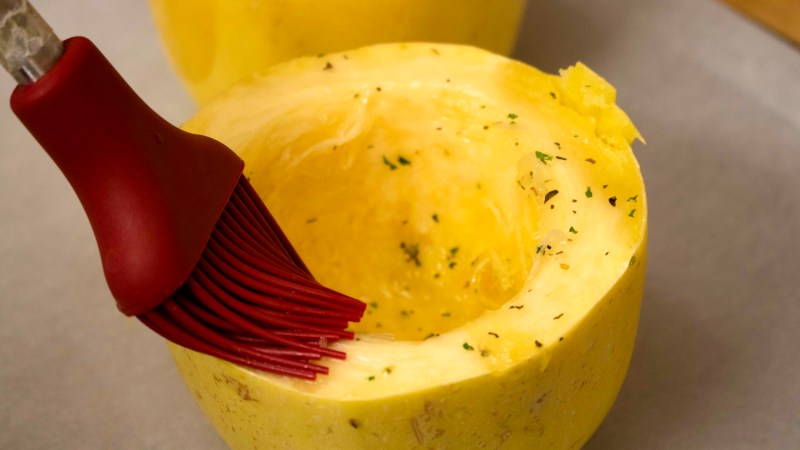With the rising popularity of gluten-free and low-carb eating, spaghetti squash has become something of a power food lately. It has all the yummy qualities you’ve come to know and love from other squash varieties, and its noodle-like interior texture makes it a perfect delivery vessel for your favorite pasta recipes. To get the most out of this unique vegetable, preparation is key. Read on to find out how to cook spaghetti squash in our step-by-step guide.

1. The first step in prepping your squash is to cut it in half. You can split the squash either lengthwise or width-wise, but doing it width-wise will give you longer, more spaghetti-like strands. The skin of spaghetti squash can be quite tough, so to make cutting easier, create several puncture marks along the area where you’ll be cutting and throw the whole squash in the microwave for 4-5 minutes to soften it up.

2. Once your squash is softened, trim off the top and bottom, leaving a flat surface on each end. Then slice the squash along your perforated line to split it into two halves.

3. Next, you need to remove the seeds from each half. Start by cutting around the center with a knife.

4. Use a spoon to scoop out all of the seeds at the center.

5. Once you’ve removed all of the seeds, you should be left with two squeaky clean squash “bowls.”

6. Spaghetti squash holds a lost of moisture, so it’s a good idea to draw some of that out before you begin cooking. To do this, liberally sprinkle salt over the rim and interior of each half and let the squash sit for about 15 minutes.

7. After those 15 minutes, you should see beads of moisture collected along the rim and in the interior of your squash. Wipe this moisture (along with any remaining salt) away with a paper towel.

8. It’s time to add some flavor! Mix about a tablespoon of olive oil with your favorite spice blend (we like to combine parsley, oregano, basil, and garlic powder) and brush the mixture liberally over the interior of the squash.

9. Top each half with a light dusting of salt and pepper to taste.

10. Line a baking sheet with parchment paper or aluminum foil to make cleanup easy. Place each half of your squash face down on the pan. Placing the halves face down will allow additional moisture to run off onto the pan while they’re cooking, making for a better final texture.

11. Bake your squash at 375 degrees Fahrenheit for 35 to 40 minutes, until its nicely roasted and golden brown.

12. Using a fork, pull the strands of squash away from the skin and into the center of each half. Now you should start to see where this veggie gets its name.

13. You can serve your noodles directly in the squash bowls or you can pull out the strands and transfer them into a dish.

14. Top or toss with your favorite sauce (and any other ingredients you want to throw in), then enjoy a delicious squash-noodle feast!


